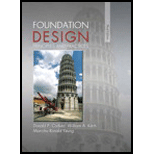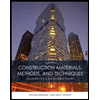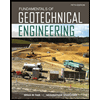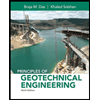
Foundation Design: Principles and Practices (3rd Edition)
3rd Edition
ISBN: 9780133411898
Author: Donald P. Coduto, William A. Kitch, Man-chu Ronald Yeung
Publisher: PEARSON
expand_more
expand_more
format_list_bulleted
Concept explainers
Textbook Question
Chapter 3, Problem 3.13QPP
Explain the difference between the drained condition and the undrained condition.
Expert Solution & Answer
Learn your wayIncludes step-by-step video

schedule04:32
Students have asked these similar questions
please help
AS
Q1/ The specific gravity of the soil is 1.41 percentage of water content by weight at
field capacity and wilting point are 15% and 7% respectively calculate the
equivalent moisture content as equivalent depth for 1.2m root zone :
1. at permanent wilting point
2. at field capacity
3. for ready available water
Question 6
The following figure shows peak-hour volumes for an intersection. Using Webster's method, determine
a suitable signal timing for the intersection using the four-phase system shown below. Use an amber
interval of 3 seconds and the saturation flow given in the table.
O
100
O
Phase
Lime Group
Saturation Flow
A
e
1615->
370
3700
B
1615
1615
3700
1615
3700
Chapter 3 Solutions
Foundation Design: Principles and Practices (3rd Edition)
Ch. 3 - Explain the difference between moisture content...Ch. 3 - A certain saturated sand has a moisture content...Ch. 3 - Consider a soil that is being placed as a fill and...Ch. 3 - A sample of soil has a volume of and a weight of...Ch. 3 - A site is underlain by a soil that has a unit...Ch. 3 - The sub-surface profile at a certain site is shown...Ch. 3 - A vertical load of 300 kN is applied to a area at...Ch. 3 - A vertical load of 20 k is applied to a area at...Ch. 3 - 3m3m footing is to be built on the surface of a 15...Ch. 3 - A 3 ft square footing carries a sustained load of...
Ch. 3 - A 2m thick fill is to be placed on the soil shown...Ch. 3 - Estimate the effective friction angle of the...Ch. 3 - Explain the difference between the drained...Ch. 3 - A soil has c=5 kPa and =32. The effective stress...Ch. 3 - A footing with an embedment of 2 m is embedded in...Ch. 3 - Prob. 3.16QPPCh. 3 - Prob. 3.17QPPCh. 3 - A 9 ft thick fill is to be placed on the soil...
Additional Engineering Textbook Solutions
Find more solutions based on key concepts
Porter’s competitive forces model: The model is used to provide a general view about the firms, the competitors...
Management Information Systems: Managing The Digital Firm (16th Edition)
Write a summary list of the problem-solving steps identified in the chapter, using your own words.
BASIC BIOMECHANICS
In a class definition, is the body of any method definition ever part of the class interface?
Java: An Introduction to Problem Solving and Programming (8th Edition)
1 void product() { 2int, a = 6; 3int b = 5; 4int c = 4; 5int result = a b c; 6System.out.printf("Result is %d...
Java How to Program, Early Objects (11th Edition) (Deitel: How to Program)
T F ofstream objects, by default, delete the contents of a file if it already exists when opened.
Starting Out with C++ from Control Structures to Objects (9th Edition)
The resistance and inductance of the circuit in Fig. 8.5 are 100 and 20 mH, respectively.
Find the value of C t...
Electric Circuits. (11th Edition)
Knowledge Booster
Learn more about
Need a deep-dive on the concept behind this application? Look no further. Learn more about this topic, civil-engineering and related others by exploring similar questions and additional content below.Similar questions
- PHF-0.91 Pedestrian volume is negligible. Question 7 A parking area with 60 bays has an initial count of 35 vehicles. The in-out survey data for 10-minute intervals is as per the table below. Complete the table, calculate the accumulation, occupancy (%), and parking load (veh.hrs) for each interval. Time (min) In Out Accumulation Occupancy Parking load (%) 0 3 10 2 4 20 1 1 30 1 3 40 1 6 50 1 4 60arrow_forwardQ3/ The following data represent the water depth in the soil of equal areas for specified field. Calculate the uniformity coefficient, efficiency and adequacy of irrigation. Net needed irrigation depth =75 mm (78-04, 79, 88, 85.21, 76,82)arrow_forwardA (A) Q1/ It is required to apply a net depth of 120mm to a total area of 60 ha. The applied discharge is continuously 180 L/s. What must be the time of irrigation? Assume the application efficiency 85%. а Eas 85 0% tarrow_forward
- The following figure is a flexible pavement system with the resilient moduli layer coefficients and drainage coefficients as shown. If the predicted ESAL = 6x106, Reliability, R = 99%, Standard Deviation (So) = 0.45, and APSI = 2.5, select thicknesses D1, D2, and D3 in accordance with the AASHTO Guide for Design of Pavement Structures. E₁ = 400, 000 psi; a₁ = 0.42, Thickness = D₁ E₂=30,000 psi; a₂= 0.14, m₂ = 1.2; Thickness = Dz E=11,000 psi; a=0.08, m3 = 1.2; Thickness = D3 MR= 5,700 psiarrow_forwardDiagramtically show the placement, size, and spacing of temperature steels, dowel bars and tie bars in rigid pavements. Also mention their puproses in rigid pavements.arrow_forwardA six-lane concrete roadway is being designed for a metropolitan area. This roadway will be constructed on a subgrade with an effective modulus of subgrade reaction k of 200 lb/in^3. The ESALs used for the design period is 6.0×10^6. Using the AASHTO design method, determine a suitable thickness of the concrete pavement (to the nearest 1/2 inch), provided that the working stress of the concrete to be used is 600 lb/in^2 and the modulus of elasticity is 6×10^6 lb/in^2. Assume the initial serviceability is 5.0 and the terminal serviceability is 2.0. Assume the overall standard deviation, So, is 0.35, the load transfer coefficient J as 3.2, the drainage coefficient, Cd, is 1.15, and R = 99%.arrow_forward
- A 12-in. full-depth asphalt pavement is placed on a subgrade with aneffective roadbed resilient modulus of 7,000 psi. Assuming a layer coefficient of 0.44 for the hot mix asphalt, a drop in PSI from 4.5 to 2.5, an overall standard deviation of 0.49, and a predicted ESAL of 10 X 10^6, determine the reliability of thedesign by using the AASHTO equation and check the result by using the AASHTO design chartarrow_forwardGiven the monthly resilient modulus below, find out relative damage of each month, the average relative damage and the effective roadbed resilient modulus.Month Resilient Modulus (psi):Jan 20,000Feb 22,000March 5,000April 6,000May 7,000June 8,000July 8,500August 9,500September 9,000October 8,000November 7,000December 18,000arrow_forwardDetermine the largest torque T that can be applied to each of the twoaluminium bars shown in Figure 5 below, and the corresponding angle of twistat B, knowing that allow = 50 MPa and G = 26 GPa. [10]Figure 5 : Aluminium Bars(Source: Mechanics of Materials Beer, Johnston, DeWolf & Mazurek 6Ed p204)arrow_forward
- Assume a car park facility where the arrival rate is λ customer every minute, and the service process including pressing the button, taking the card, and waiting for the boom to rise leads to service rate of μ customer every minute. a. Assume the arrival and service processes are stochastic. Using any software (Excel, Matlab, or the one you prefer), plot average delay time (including service time) and average queue size (including the vehicle currently being served) for all combinations of λ = {1,2,3,..,10} and p = {0.1,0.3,0.5,0.7,0.9}. Specifically, we ask you to make 2 graphs (one for average delay and the other for average queue size), where the x-axes contains the different values for 1, and where you make one curve for each p. b. Assume the arrival process is stochastic but the service process is deterministic with rate µ. Using any software (Excel, Matlab, or the one you prefer), plot average delay time (including service time) and average queue size (including the vehicle…arrow_forwardConsider, M people (aka pax) who want to travel by car from O to D. They all start working at D at Q (e.g., Q-8am). If a person departs at time t, assume the time needed to go from O to D is given by c(t)=A+Bx(t), where x(t) is the flow of people departing at time t [car/unit of time]. In addition, a is the penalty for being early at work (E(t) is how early the person arrived when departing at time t), and ẞ is the penalty for being late at work (L(t) is how late the person arrived when departing at time t). Assume 0 < a < 1 < ß. Further assume the departure time choice problem under the equilibrium conditions. Prove that the arrival time of people who depart when most of the M people start their trips is equal to Q.arrow_forwardConsider, M people (aka pax) who want to travel by car from O to D. They all start working at D at Q (e.g., Q=8am). If a person departs at time t, assume the time needed to go from O to D is given by c(t)=A+Bx(t), where x(t) is the flow of people departing at time t [car/unit of time]. In addition, a is the penalty for being early at work (E(t) is how early the person arrived when departing at time t), and ẞ is the penalty for being late at work (L(t) is how late the person arrived when departing at time t). Assume 0 < a < 1 < ß. Further assume the departure time choice problem under the equilibrium conditions. Prove that the arrival time of people who depart when most of the M people start their trips is equal to Q.arrow_forward
arrow_back_ios
SEE MORE QUESTIONS
arrow_forward_ios
Recommended textbooks for you
 Construction Materials, Methods and Techniques (M...Civil EngineeringISBN:9781305086272Author:William P. Spence, Eva KultermannPublisher:Cengage Learning
Construction Materials, Methods and Techniques (M...Civil EngineeringISBN:9781305086272Author:William P. Spence, Eva KultermannPublisher:Cengage Learning Principles of Foundation Engineering (MindTap Cou...Civil EngineeringISBN:9781337705028Author:Braja M. Das, Nagaratnam SivakuganPublisher:Cengage Learning
Principles of Foundation Engineering (MindTap Cou...Civil EngineeringISBN:9781337705028Author:Braja M. Das, Nagaratnam SivakuganPublisher:Cengage Learning Fundamentals of Geotechnical Engineering (MindTap...Civil EngineeringISBN:9781305635180Author:Braja M. Das, Nagaratnam SivakuganPublisher:Cengage Learning
Fundamentals of Geotechnical Engineering (MindTap...Civil EngineeringISBN:9781305635180Author:Braja M. Das, Nagaratnam SivakuganPublisher:Cengage Learning Principles of Foundation Engineering (MindTap Cou...Civil EngineeringISBN:9781305081550Author:Braja M. DasPublisher:Cengage Learning
Principles of Foundation Engineering (MindTap Cou...Civil EngineeringISBN:9781305081550Author:Braja M. DasPublisher:Cengage Learning Principles of Geotechnical Engineering (MindTap C...Civil EngineeringISBN:9781305970939Author:Braja M. Das, Khaled SobhanPublisher:Cengage Learning
Principles of Geotechnical Engineering (MindTap C...Civil EngineeringISBN:9781305970939Author:Braja M. Das, Khaled SobhanPublisher:Cengage Learning Traffic and Highway EngineeringCivil EngineeringISBN:9781305156241Author:Garber, Nicholas J.Publisher:Cengage Learning
Traffic and Highway EngineeringCivil EngineeringISBN:9781305156241Author:Garber, Nicholas J.Publisher:Cengage Learning

Construction Materials, Methods and Techniques (M...
Civil Engineering
ISBN:9781305086272
Author:William P. Spence, Eva Kultermann
Publisher:Cengage Learning

Principles of Foundation Engineering (MindTap Cou...
Civil Engineering
ISBN:9781337705028
Author:Braja M. Das, Nagaratnam Sivakugan
Publisher:Cengage Learning

Fundamentals of Geotechnical Engineering (MindTap...
Civil Engineering
ISBN:9781305635180
Author:Braja M. Das, Nagaratnam Sivakugan
Publisher:Cengage Learning

Principles of Foundation Engineering (MindTap Cou...
Civil Engineering
ISBN:9781305081550
Author:Braja M. Das
Publisher:Cengage Learning

Principles of Geotechnical Engineering (MindTap C...
Civil Engineering
ISBN:9781305970939
Author:Braja M. Das, Khaled Sobhan
Publisher:Cengage Learning

Traffic and Highway Engineering
Civil Engineering
ISBN:9781305156241
Author:Garber, Nicholas J.
Publisher:Cengage Learning